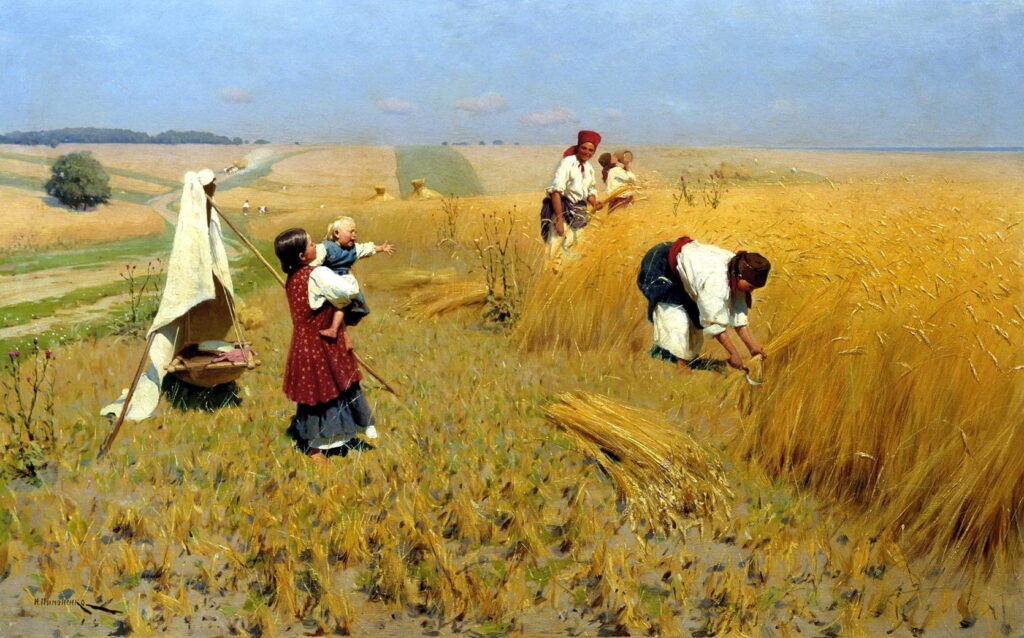A to Z of Landscapes: Yellow

As we near the end of this alphabet of landscape painting, this week we reach the letter y, standing for yellow, one of the most important and versatile colours in the artist’s palette. It’s most strongly associated with late summer, when much of the countryside has become dry and turned from the green of Spring to the yellows of ripened grain, ready for harvest.
Pieter Bruegel the Elder (c 1525–1569), The Harvesters (1565), oil on panel, 119 x 162 cm, Metropolitan Museum of Art, New York, NY. Wikimedia Commons.
Perhaps the earliest complete visual reference to the grain harvest is Pieter Bruegel the Elder’s The Harvesters from 1565. This shows each step in the traditional and labour-intensive processes of cutting the ripe crop, gathering it into stooks, transporting it by cart for threshing, and onward transfer of grain to the waiting ships in the far distance.
Samuel Palmer (1805–1881), Oak Trees, Lullingstone Park (1828), pen, brush, brown Indian ink, graphite, watercolor, gouache and gum arabic on wove paper, 29.5 × 46.8 cm, National Gallery of Canada, Ottawa. Wikimedia Commons.
In 1826, the young British painter Samuel Palmer moved to the rural village of Shoreham in Kent, in the valley of the River Darent to the north of Sevenoaks, where he spent much of the next decade producing some of his most distinctive work. For Palmer, the village and its environs became his ‘land of milk and honey’, in a Biblical vision of Beulah. His finely-detailed Oak Trees, Lullingstone Park was painted two years later, in 1828. This shows ancient oaks in the deer park of Lullingstone Castle, in the Darent Valley of Kent, between Eynsford and Shoreham, with their leaves turned yellow in the early autumn.
Samuel Palmer (1805–1881), The Golden Valley (c 1833-4), watercolour and gouache, 12.7 x 16.5 cm, Private collection. WikiArt.
Towards the end of his time in Shoreham, Palmer’s views started to open out into more conventional landscapes, such as The Golden Valley (c 1833-34), caught here at the end of the harvest.
Charles-François Daubigny (1817–1878), The Harvest (1851), oil on canvas, 135 x 196 cm, Musée d’Orsay, Paris. Wikimedia Commons.
Painted three centuries after Pieter Bruegel the Elder’s encyclopaedic account, Charles-François Daubigny’s Harvest from 1851 is remarkably similar, although its yellows are more muted.
Volodymyr Orlovsky (1842–1914), Harvest in Ukraine (1880), oil on canvas, 80.6 x 171 cm, location not known. Wikimedia Commons.
Further afield, in the vast cereal-growing lands of Ukraine, Volodymyr Orlovsky’s Harvest in Ukraine (1880) shows laborious hand-cutting of grain on the steppe, and demonstrates the origin of the Ukrainian flag of blue and yellow.
Mykola Pymonenko (1862–1912), Harvest in Ukraine (1896), oil on canvas, 87 x 140 cm, location not known. Wikimedia Commons.
Mykola Pymonenko’s classic view of Harvest in Ukraine from 1896 follows a compositional formula developed by Jules Bastien-Lepage for Naturalist paintings. Its horizon is high, about three-quarters of the way up the canvas. The women in the foreground and the child’s cradle are painted in fine detail, and their edges are so crisp that they pop out. As the figures and fields recede into the background, they rapidly lose detail and their edges blur. The effect is of a vivid reality at the focus of the image, with deep recession to the distant horizon.
Camille Pissarro (1830-1903), The Gleaners (1889), oil on canvas, 65.5 x 81 cm, Kunstmuseum, Basel, Switzerland. WikiArt.
Camille Pissarro started work on his intensely sensory and idyllic painting The Gleaners in early 1888, using a squared-up study in gouache to finalise his composition. He found the Divisionist technique hard, and wrote that he needed models so that he could complete its detail, which he did later the following year.
Adrian Stokes (1854–1935), Harvest Time in Transylvania (c 1909), oil on canvas, other details not known. Wikimedia Commons.
British painter Adrian Stokes travelled to Romania in eastern Europe for this golden view of Harvest Time in Transylvania (c 1909), one of many paintings he and his wife Marianne made of their protracted visits.
Grant Wood (1891–1942), Fall Plowing (1931), oil, dimensions and location not known. Wikimedia Commons.
Grant Wood’s Fall Plowing from 1931 is set in the prairie of Iowa, where it shows ripe and harvested cereals, and a recently developed walking plough with a steel ploughshare, an important advance in cultivating the prairie.
Henry Herbert La Thangue (1859–1929), In the Orchard (1893), oil on canvas, dimensions and location not known. Wikimedia Commons.
Henry Herbert La Thangue painted In the Orchard in 1893, presumably in Sussex, England, using a profusion of fine marks more typical of Impressionism. Although the figures and baskets of fruit are quite tightly detailed, much of the rest of his canvas is more painterly and atmospheric.
Yellow has also been used in combination with blues and greens to create colours closer to those in nature. In some cases, even into the twentieth century, the yellow used hasn’t proved lightfast, and has faded to leave foliage appearing blue.
Adriaen van de Velde (1636–1672), Vertumnus and Pomona (1670), oil, 76.5 x 103 cm, Kunsthistorisches Museum, Vienna. Wikimedia Commons.
This is all too sadly evident in Adriaen van de Velde’s otherwise superb Vertumnus and Pomona from 1670.
Carl Blechen (1798–1840), View of Assisi (1832-35), oil on canvas, 97 x 147 cm, Neue Pinakothek, Munich, Germany. Wikimedia Commons.
Carl Blechen used lightfast chrome yellow extensively in his imposing View of Assisi, painted in 1832-35. By this time, the mixture of chrome yellow with Prussian blue had become known as green cinnabar or chrome green, although the chromium salt used was yellow in colour, not green.
Paul Cézanne (1839–1906), The Railway Cutting (c 1870), oil on canvas, 80 × 129 cm, Neue Pinakothek, Munich, Germany. Wikimedia Commons.
Chrome yellow was widely used by the Impressionists and shown at the Salon, and is demonstrated well in Paul Cézanne’s famous painting of The Railway Cutting (c 1870). Most if not all of the greens seen here most probably rely on chrome yellow mixed with blue.




